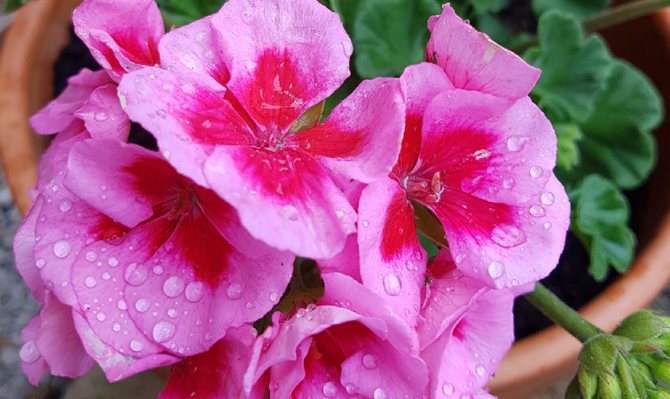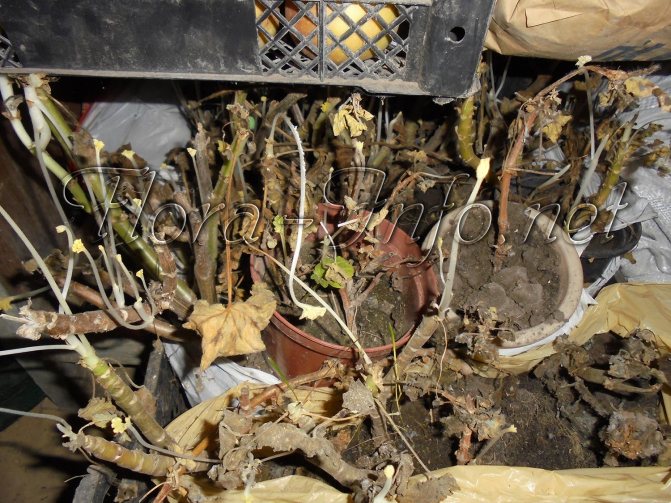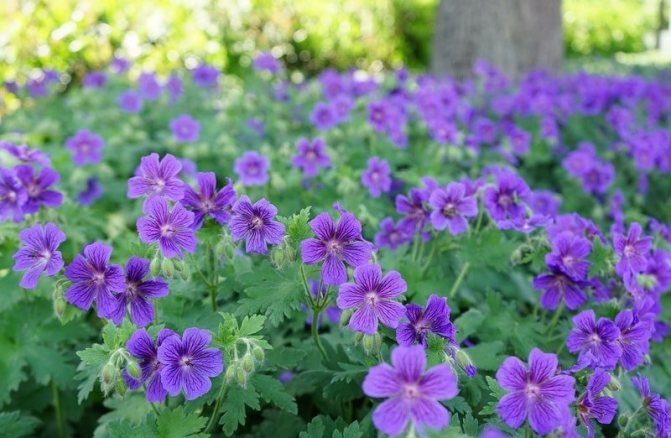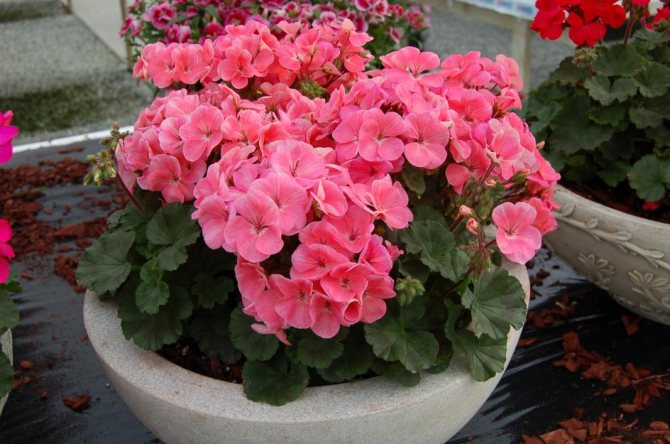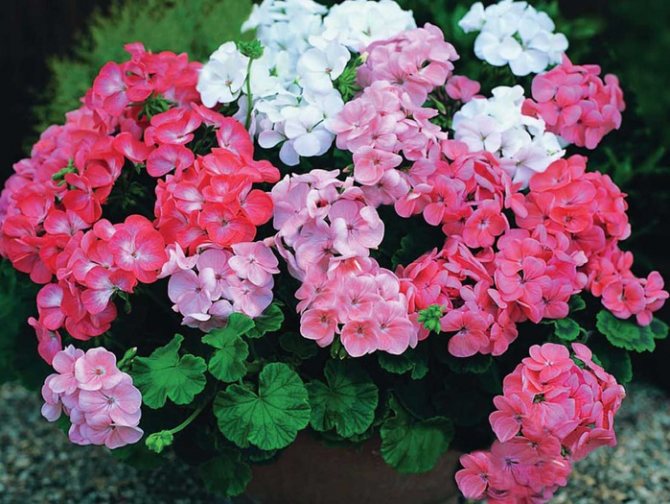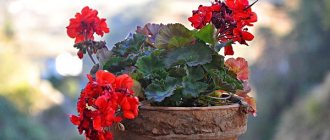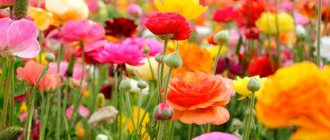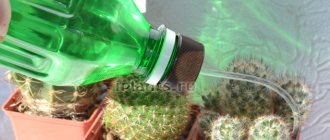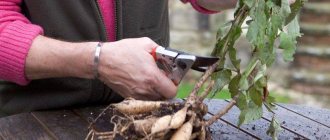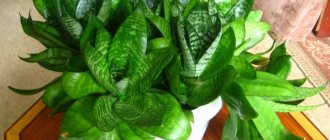Initial temperature drops are not dangerous for pelargoniums. The first, as a rule, small frosts are not dangerous for pelargonium, therefore, when they occur, you should not move all containers in a panic in the room. Only morning temperatures below -3 ° C begin to damage the flowers and sensitive growth peaks, causing these parts of the pelargonium to appear withered.
During the day, symptoms disappear as the temperature rises. And this is the perfect time to transfer pelargoniums to the premises in which they will spend the winter. This moment, as a rule, falls at the turn of October and November. If the pelargoniums were grown outdoors, it is necessary to dig them up along with a fairly large root ball. The geraniums dug in this way are transplanted into pots with a diameter of about 20-25 cm. The pots are filled with drainage.
Instead of pots, there might be one large drainage box at the bottom if you have enough room for it. Geraniums are planted in such a box at intervals of about 25 cm. After placing pelargonium in a pot or box, everything is covered with earth, in which earth from the garden, flower soil, and even sand can be located. Geraniums that have been growing all summer in a container on a balcony or terrace are simply transferred indoors.
Preparing for wintering: pruning
Preparation for the dormant period begins in the fall, and the most important thing to do is to prune geraniums. This will ultimately make a huge difference in how it blooms. Without pruning, even if all the necessary conditions set out below are met, such lush and beautiful flowers will not appear on the plant.
Geranium pruning procedure:
- At the end of September, absolutely all flower stalks are cut, regardless of whether they have faded or are still actively doing it. This is done in order to help geraniums conserve their resource reserves for the winter.
- All the leaves that have already turned yellow and withered or have just begun to do so are pinched off or cut off. Experienced growers recommend pinching them off rather than cutting them off with scissors. In the second case, there are mere protruding roots.
- For dense flowering in September, geraniums are cut so that the beginning of branching remains, or slightly higher (3 - 5 cm) of the node. The top cut can be rooted like a cutting.
You need to prune the plant until it loses its beautiful and lush appearance. If the plant is young, then only
, and do it according to the following rules:
- The pinching of young plants begins when their height reaches 5 - 6 cm.
- After the geranium grows another 5 cm, pinching is done again.
- To achieve a spherical shape, you can pinch 3 times in the same way.
Knowing how to properly handle geraniums during its dormant period, you can not be afraid that it will not bloom in the summer. And absolutely everyone can provide these conditions for this, regardless of their floriculture skills.
If you find an error, please select a piece of text and press Ctrl + Enter
.
Geranium is a very beautiful and unpretentious flower that has always been popular.Even before the revolution, pots of geraniums could be seen on the windowsills in almost every peasant, bourgeois and aristocratic house. People have long known about the healing properties of the plant. Geranium is used in medicine, and being taken out into the garden in the summer, it relieves its green neighbors of aphids. In a word, geranium (pelargonium) has been a good companion of people for many years. How to care for geraniums?
Geranium will take root in every apartment, you just need to provide it with minimal comfort - sufficient, but not excessive watering, good lighting, the air temperature is above + 12 C. Since geranium came to us from southern countries, it does not tolerate frost, except for the garden variety, which in the middle zone of Russia can even hibernate in the open field.
In summer, geranium will be grateful to you if you take it out into the open air - on the balcony, or take it with you to the country. However, it is better to leave the plant in a pot, not to plant it in the ground. It does not tolerate a second transplant and may die in the winter. In the fall, you will be surprised at how lush and elegant the flower will become, what bright color its leaves will acquire.
Wintering of large-flowered pelargonium
Large-flowered geraniums should not go through a pronounced dormant period like zoned pelargoniums and can be stored at higher temperatures. In order for them to bloom again in spring, they must be stored in a well-lit room with a temperature of 12-14 ° C, but no more! In such conditions, they will grow all the time. They need 2 months to create new flower buds.
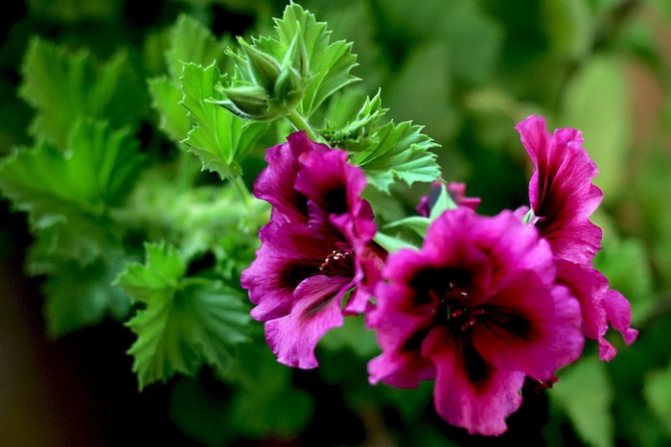
When you notice the first buds, you need to raise the temperature to 18 ° C. Thanks to these conditions of winter keeping, geraniums will bloom in April. If for some reason you cannot provide the plant with the above conditions, it is necessary to overwinter geraniums in the same way as the previous zonal pelargonium. Then the plant will remain dormant. It will not harm them, they will just bloom a little later.
Types and varieties of plants
Most often, flower lovers grow zonal pelargonium. This group, in turn, is divided into subgroups, differing in the shape of flowers, plant height, and leaf color.
So, according to the shape of a geranium flower, there are:
- Non-double.
- Terry.
- Rosaceae.
- Star-shaped.
- Cactus.
- Tulip-shaped.
- Bird eggs.
- Speckled.
- Cloves.
- Phlox-like.
Based on the size, geraniums are distinguished:
- standard - from 30 to 50 cm;
- dwarf - up to 25 cm;
- miniature - up to 15 cm.
Pelargonium leaves can be green or variegated when various shades are beautifully combined with each other - from bright green to deep purple.
What other types of flower can be distinguished?
- Truss geranium is intended for flowerpots, as its branches hang down.
- Scented pelargonium is preferred by many flower lovers, as it has a distinctly pleasant aroma. It can be different - for example, it resembles the smell of roses or nutmeg.
- For royal geraniums, a special feature is the dark spots on the flower petals.
- Angels are a type of pelargonium characterized by long flowering and delicate aroma.
- Garden geranium is intended for growing in flower beds, has a well-developed root system.
In addition, there are many hybrids that are popular with flower growers. In the end, every geranium lover collects a whole collection of different varieties on his windowsill.
Bush formation
Often people are disappointed when an ugly plant with broken shapes grows in them. In fact, this is a feature of pelargonium that must be reckoned with. Pruning should be done regularly. If this is not done, the plant will stretch out, it will be less willing to bloom, in addition, uncut geranium is prone to various diseases.
Most of all, zonal varieties need pruning, while it is necessary to calculate that at least 3 months must pass from this procedure to flowering in order for a flower bud to form. Pruning is usually done in the fall using sterile instruments. Don't forget to ask your friends who needs indoor geraniums. Home care, reproduction is not difficult or cumbersome, and just at the time of pruning, you can share the cuttings.
How to care for geraniums at home for beginners
Although it is an undemanding plant, it will bloom profusely only with proper care. This is a sufficient amount of light, regular but moderate watering, an acceptable temperature.
Ground requirements
Geranium does not have any special requirements for the soil. It is easier to buy any ready-made soil for flowers, from those that are sold in stores. It usually contains peat, which is very good for geraniums.
It is even better if it is possible to add river sand and perlite to the soil.
If the soil mixture is prepared independently, it is advisable to mix turf, humus and sand in the following proportions 8: 2: 1.
Temperature, humidity, lighting
Pelargonium will grow normally and develop at normal room temperature. In winter, the thermometer in the room where the flower is located should not fall below + 12 C.
Caring for geraniums means providing adequate lighting. She loves light. If the pot is placed on the north window, the leaves will begin to fade. But in summer, on hot days, it is still better not to keep it in the bright sun so that the plant does not get burns, especially after watering
Pelargonium tolerates both dry and humid air, but does not like spraying. Better in good weather to take it out on the balcony to let the plant "breathe".
Watering the plant
Watering frequency depends on the season. In the warm period, indoor geraniums are watered more often and more abundantly - this plant loves water very much. In winter, the frequency of watering is reduced - it is enough to "water" the flower once a week. But if the air in the rooms is dry, and the soil in the flower pots dries out quickly, you will have to water more often.
Top dressing and fertilization
Like other indoor plants, pelargonium requires complex fertilizers, which include nitrogen, phosphorus and potassium. It is optimal if they are included in the composition of the dressing in equal proportions.
It will be most convenient to purchase a mixture for flowering plants in the store, where the fertilizer additionally contains manganese, copper, and iron.
Those who feed the flowers on their own can add a drop of iodine to a liter of water. But in this case, you should pour the top dressing carefully, along the edges of the pot. Otherwise, iodine, especially in excessive concentration, can burn the roots.
In the summer they are fed 2 times a month, in the spring and autumn - once a month; in winter, fertilizers can be omitted.
Top dressing must be done by removing the pot from the illuminated window. Beforehand, the flower is well watered so that the mineral additives that make up the fertilizer do not damage the root system.
But geranium does not like manure and other organic fertilizers - it is better not to experiment with them.
Pruning and replanting
Pelargonium is one of those plants that stop blooming if transplanted into a pot that is too spacious. In this case, the root system begins to develop vigorously, mastering the space, and the flowers do not bloom.
So geraniums are usually transplanted only in the following cases:
- If the root system has grown too much, it is already visible above the ground.
- If the plant gets sick, for example, it starts to rot from over-watering.
A new pot is chosen so that the roots fit completely into it.
It is better to replant the plant in early spring. In advance, you should stock up on drainage and suitable soil - purchased or prepared yourself.
Geranium is carefully removed from the pot, trying not to damage the roots, and watered abundantly in a new place.
In the fall, it should be cut off, removing the shoots coming from the leaf axils. No more than 7 leaves should remain on the stem.
How to welcome spring
Closer to spring, when the temperature outside will reach 2 degrees above zero, you can take out the pelargonium pots to the balcony. You need to start with half an hour, gradually increasing the residence time of the geranium on the balcony. This way you can help the pelargonium bloom constantly.
- If the geranium was stored in the basement, then you need to soak the bundles in water with fertilizer before taking it outside, then plant it in a pot.
- The potted geranium should be kept indoors for about a week. Only after the onset of the last frost is pelargonium planted in a garden flower garden.
Thus, geraniums should be placed in a cool room in winter, provide additional lighting and monitor soil moisture. You also need to break off dried leaves and peduncles from time to time. Subject to all these simple rules of pelargonium, we will delight with our flowering and aroma immediately after leaving the rest phase.
Examine the plants every month to see if they are getting too dry and wrinkled. Spray suspended plants with water if necessary. If the geraniums become so dry that the stems begin to shrink, remove them from the bags and soak the roots for an hour or two in cool water. After soaking in water, let them dry before placing them in paper bags. Do this several times during the winter to keep the plants from drying out. For plants that have wintered, it may take several weeks to start growing again in the spring.
Care for geraniums in the fall, preparation for winter.
In September, pelargoniums, if they spent the summer outdoors, are brought into the house. You need to water the flowers less often, and the amount of fertilizer is also reduced.
When the plant adapts to new conditions of keeping, excess shoots are cut off. Royal geraniums are pruned a little later, in late autumn. It is better to do this at the end of October or November.
For the purpose of prevention, flowers are treated with "Fundazol". They carefully examine whether they brought any pests from the garden with the geraniums.
The best option would be to put geraniums for the winter on an insulated balcony, where the temperature does not drop below + 15. But you can leave it in the room by placing the flower closer to the glass (but not in a draft).
It is advisable for miniature and variegated geraniums to provide additional lighting in winter with the help of fluorescent lamps. Watering during the cold season should be moderate but regular.
How to prepare geraniums for winter in an apartment
Glazed loggia or insulated balcony
Most of the pelargoniums overwinter on a glazed loggia, where the air temperature does not drop below + 12 ° C on frosty winter nights. In such almost ideal conditions, some of the plants continue to bloom (not as luxuriantly as in summer) for most of the winter. Some pots with bushes are placed in hanging baskets and pots, others I put on tables and a ladder for plants. This option allows you to get by with corrective pruning in the fall and more radical in late February - early March.


Watering is moderate. No top dressing. With such a content, pelargoniums bloom for a long time, and by spring they themselves go into "standby mode". The buds hardly open, allowing the plant to rest and accumulate strength. Part of the leaves periodically dries up.
Window sill
There are no problems with growing pelargonium on the windowsill. The main thing is to find a place for them. Pots or boxes are placed on foam sheets or packing troughs so as not to chill the root system. The danger is posed by open vents and transoms on frosty days. It is bad if the battery is burning nearby.Autumn pruning when grown on a windowsill is sparing, since pelargoniums do not go into hibernation and continue to bloom. But a strong spring pruning is necessary. Care comes down to a fairly rare watering, cleaning of dried leaves and peduncles and pest control.
Frost-proof garage and staircase
Many amateur gardeners I know keep flowerpots, boxes and large pots of pelargoniums in frost-free garages and stairwells in winter. Before this, the plants are strongly pruned, leaving parts with a height of 15 - 20 cm. Large branches are shortened, but not removed. It is watered several times during the winter, very sparingly, only so that the ground with the roots does not dry out.
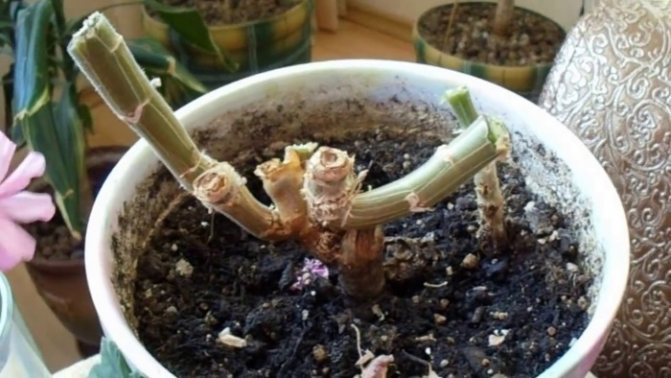

Refrigerator
When storing pelargonium in the refrigerator (on the top shelf, shelves on the door, in vegetable drawers), you must first work with the bushes. In dry weather at the end of September or in October (for weather and life circumstances), pelargoniums are removed from the soil along with the root system. After that, most of the roots are carefully cut off, leaving a root ball with soil (about 8-10 cm).
This lump does not need to be moisturized, it is better if it is dry enough. It is wrapped in foil so that the earth does not spill out. Pelargonium is cut off, leaving a stump from the ground part of such a size that two plants fit in a liter bag of juice or milk. The package is wrapped in a newspaper folded in several parts. The condition of the stored pelargonium is checked from time to time. Look to see if the paper is wet. In February, pelargoniums are taken out, planted in containers and start germination.
"Head down"
There are many other options for preserving pelargonium brought from the site to the house. Among them, attention is drawn to the hanging of the bush "upside down", when a lump of shortened roots with soil or peat is packed in a plastic bag, tightly tied and hung from a hook or shelf in a cool place (for example, in the basement). The ground part is also greatly shortened. Experts consider this unusual option for wintering pelargoniums to be very effective and guaranteeing lush flowering for the next year.
Old gardeners say it would be a good idea to sprinkle sulfur powder on the roots to keep the roots from rotting.
At the end of winter, geraniums are transferred from the basement, pulled out of paper and the rotten roots are cut off. After that, they are planted in fresh, moist soil. Watering is necessary only when the first leaves appear on the stems.
Disease and pest control
Geranium is a healthy plant, and yet it happens that the flower is sometimes affected by pests or various ailments.
The following diseases are most common:
- Gray rot
on the leaves. The diseased leaves are carefully removed, and the bush is sprayed with antifungal drugs. - Root rot
- occurs with frequent watering. It is advisable to transplant the flower by cutting off the decayed roots. - Whitefly.
You can suspect the appearance of a pest if the geranium leaves suddenly began to turn yellow. You will need a drug such as Actellic. The processing may have to be done several times. - Powdery mildew.
The leaves acquire a characteristic appearance, covered with a whitish coating. This is a fungal disease, and it is necessary to treat it using Topsin-M or Topaz preparations. - Aphid.
Tiny creatures can be seen on the undersides of the leaves. There are many drugs in stores that will help get rid of pests. - Rust
is a fungal disease, it is characterized by the appearance of rusty spots on the leaves. For treatment, fungicides are used.
In addition, geraniums can get sick and stop blooming if the conditions of detention are violated. For example, there is not enough light or the soil is too moist.
In general, subject to simple rules, a flowering bush will become the main decoration of your window.
Lighting conditions
Few indoor plants are as fond of sunlight as geraniums. How to care for geraniums at home, you can understand intuitively by observing the state of the flower. Many sources provide information that it tolerates shadow normally. Indeed, the plant will not die, but it will look very bad, and the flowering will stop. Even the leaves in the shade become small, unlike the luxurious water lilies of a healthy flower. By moving the pots to bright sunlight, you can see that the pelargonium turns into a luxurious, abundantly flowering plant before our eyes.
How to properly care for geraniums
An unpretentious culture requires minimal but proper care. If good conditions are created, then pelargonium will delight you with beautiful lush bouquets.
- Main condition - more sun
... Geranium can be placed even in direct sunlight. To avoid burning the leaves, it is covered only on overly hot days. - Watering
... Hard cold water is unacceptable. In winter, it is necessary to water 2 times a week, without getting on the leaves. In summer, daily watering is necessary, but without excessive moisture, so as not to lead to decay of the roots. - In order to prevent stagnation of water, it is necessary to make a good drainage
... A pot for geraniums should be chosen small in size so that it is completely filled with roots. - Air humidity
... The culture does not like spraying, flushing the foliage. A wet state is very dangerous for her. - Indoor geranium is demanding on soil
... It is necessary to prepare a mixture consisting of peat, garden soil and sand in equal proportions. Likes frequent loosening so that air can easily penetrate to the roots. - Blooming geraniums should receive such fertilizers
, where there is a lot of phosphorus and potassium, but she does not like fresh organic fertilizers, she tolerates mineral fertilizers better. - After flowering, she needs nitrogen feeding
... Fertilizers should be applied once a week from April to early autumn. After transplanting for 2 or 3 months, feeding is not required.
Growing conditions and care features so that geraniums bloom


Geranium feels best in well-lit places and only on the hottest days requires light shading from the sun's rays. If the pot is exposed to the north window or turns out to be in the back of the room, the grower should expect that, with a lack of lighting, the shoots will stretch out, the plant will lose its compactness and decorative effect.
How to care for geraniums at home if there is no way to bring it out into the light, or a lack of lighting threatens the plant in winter? In winter, when keeping on a loggia or on northern windows, it is useful to use special phytolamps. Extending daylight hours to 12-14 hours has a good effect:
- to preserve the shape of the bush;
- on the uniformity of growth of shoots and their quality.
In geranium bushes that receive enough light, the newly formed stems have a rich color. The same applies to foliage, which does not become smaller or paler, but remains juicy and bright.


In order for geraniums to bloom, caring for it necessarily involves maintaining a temperature in the room that is comfortable for the culture. It is best if the air in the room where the pot stands:
- in summer it is warmed up to 22–27 ° C;
- in winter, during the dormant period, it has a temperature of about 12-16 ° C.
Plants are good for airing, but like other indoor crops, they do not like cold drafts. Being next to hot radiators, geraniums will also experience discomfort.
Causes of yellowing foliage
Newbie flower growers ask most often: why do the leaves turn yellow?
The reasons are as follows:
- A cramped pot in which it is difficult for the roots to get nutrients.
- Lack of drainage.
- Waterlogging of the soil.
- Lack of moisture.
- Incorrectly chosen place for a flower (shade, draft, near the battery).
- Incorrectly used fertilizer.
What to do if pelargonium turns yellow in summer. The first reason is improper watering. It is necessary to water so that water appears in the pan, which must be poured out immediately. If you do overflow, then do not water the flower of day 2 or 3. And pay attention to the drainage, for geraniums this is important.
Yellowing can be caused by a large temperature difference or a change in location. To relieve Pelargonium from stress, treat it with Epin Sadaptogen.
Watering plants
Now we will talk about how to water geraniums. How to care for geraniums at home, you probably already know in practice, because this plant is so unpretentious that you need to try very hard to ruin it. But it is impossible to ensure rapid growth and flowering without observing a number of rules.
Pelargonium is very fond of sunlight and regular watering, while making sure that there is no excessive waterlogging of the soil. The easiest way to adjust this mechanism is with good light soil and a drainage system. Stagnation of water at the roots leads to the death of plants, this process is especially rapid in miniature forms.
Caring for geraniums in winter requires watering restrictions. It is necessary to ensure the minimum soil moisture and prevent the roots from drying out. Geranium should not be sprayed even at the height of summer. She loves dry air.


What to do if yellowing occurs in winter
In the cold season, the reason may be a shortened daylight hours, dry air, improper watering. Sometimes it is enough to rearrange the flower in a bright place away from the heating battery.
Why does foliage dry? Dry indoor air is one of the most common causes of dry leaves. I already wrote that containers with water should be placed on batteries, for example, plastic bottles turned upside down, at the bottom of which holes are cut. Or ventilate and spray more often with a spray bottle.
If the leaves turn yellow after transplanting, then the root system is disturbed. Process geraniums with Kornevin. An overdose of fertilizers can also cause the leaves to turn yellow.
The plant can be infested with thrips. How to find? On the inside, small pimples are visible on the leaves. Treat the plant with Fitoverm, remove the affected areas.
If dark brown spots or fluffy formations appear on the stem, then this is a dangerous fungus. What to do? The affected parts should be cut off, treated with a fungicide, watering should be reduced to a minimum, at least for 7 days.
Geranium - home doctor
This beautiful flower used to be on the windowsill in every home, today it is quite difficult to meet it. Many people do not like its specific smell, others prefer decorative deciduous plants. In fact, having a pot of geraniums at home is very beneficial. Essential oils secreted by leaves are able to create a natural barrier against disease-causing bacteria and viruses. But that's not all, flower growers know how difficult it can be to treat their home garden when it is attacked by aphids. These parasites are especially common in the cold season. Therefore, the real salvation is geranium in winter. Home care for it is minimal, and placed next to other flowers (for example, fuchsia, which is often affected by aphids), it protects them.
Favorite plants of flower growers
What types of geraniums are most often grown by flower growers. The most beloved is the royal pelargonium. She flaunts with large bouquets of a very different palette: from pink to burgundy and purple. The diameter of the inflorescence can be up to 16 centimeters.
The characteristic feature of the royal flower is the grooved or wavy petals, which show stripes or a dark spot.
Fragrant geranium has a very pleasant smell, which is why it got its name. If you touch the leaves of fragrant pelargonium, then you will feel a rather strong mixture of aromas of rose, lemon, strawberry, ginger, mint.
Today, hybrids have been bred that have an apple smell, as well as nutmeg, almonds, lilacs, even kiwi and pineapple. Flowers of various shapes are pink and beautiful purple. It is from this variety that the unique geranium oil is obtained.
Every florist just dreams of planting a geranium called tulip-shaped geranium at home. The flower of extraordinary beauty amazes with its sophistication and tenderness.
The inflorescences are similar to unopened tulips. They form pretty little bunches, which attracts florists.
Breeders have bred 14 varieties that have colors: from pale pink to a breathtaking shade of raspberry!
If you want to add an exquisite touch to your interior, then plant ampel geraniums in the flowerpot. Pink, snow-white, red, purple lilac, lavender inflorescences will complement the interior of any room.
Ampel Pelargonium is a rather capricious plant, but with proper care, it will delight you with lush flowering.
Description of the plant
Pelargonium is a genus of plants in the Geranium family. Naturally, it grows in South Africa. This genus includes about 250 species. The smell of pelargonium is very specific, it cannot be confused with anything. The essential oils found in the leaves of the plant create a natural barrier to bacteria and viruses.
ATTENTION: Many people think that pelargonium and geranium are one and the same, but they are not. Geranium, or crane, is also a representative of the genus of the geranium family.
Geraniums native to the wild. In Russia, it is not customary for flower growers to distinguish between these kinds of plants, considering the words "geranium" and "pelargonium" to be synonyms. Geranium is used in folk medicine: for insomnia, depression, rheumatism, heart disease.
If aphids attacked domestic flowers, then it is advised to put a pot of pelargonium next to them, which expels pests.
I want to admire flowers, but they do not bloom
In order for your indoor pelargoniums to bloom, you need not only proper care, but also secret watering with iodine water:
- Iodine - 1 drop.
- Dissolve in 1 liter of water.
- Take 50 ml of this water, then slowly pour this composition along the walls of the pot.
- After such watering, the plant begins to bloom violently!
How to make pelargonium bloom? Are there any other ways? Yes, but it's hard to believe. If your favorite flower isn't blooming, try castor oil. According to scientists, this product is a powerful stimulant of the growth and flowering of green spaces.
What to do with castor oil? To feed geraniums during the budding period, dilute 1 teaspoon of castor oil in 1 liter of water. Sprinkle the leaves of the flower, or better, pour it under the root of this culture.
After watering with castor oil, you will see how the planting will increase in growth, begin to bloom beautifully, and stop hurting. When the plant is at rest, such feeding is contraindicated.
Growth and rest periods
From December to February, pelargonium enters a dormant phase, so its growth and flowering slows down. It is for this reason that there is no need to feed the plant during this period. She needs to be allowed to grow stronger, gain strength before a new vegetative period (read about how to feed geraniums for lush flowering here, and from this article you will learn how to properly use iodine with hydrogen peroxide to feed a flower). Until about January, pelargonium will delight its owners with bright beautiful flowers. Her vegetative period begins from mid-spring to autumn..
When to water geranium
Experienced flower growers advise to find out about the surplus and lack of watering by the state of the leaves:
- if only the edges of the leaves dry, it means that the plant is experiencing a moisture deficit;
- greens are sluggish or begins to rot, then the reason is an excess of moisture;
- if the lower leaves fall, and the stem is bare, there is a lack of light.
How to pinch? To get an even lush bush, the top must be pinched at 8-10 leaves, side shoots at 6-8. Do not forget to turn the pot to the light in different directions.
How to care for geraniums in autumn and winter? Pelargonium or geranium is a plant known to many flower growers. It has excellent external characteristics and easy maintenance. Some summer residents even grow pelargonium in their summer cottage, where it serves as a real decoration for the entire backyard territory. However, the plant cannot tolerate severe frosts and cold drafts, so it is recommended to bring the flower indoors for the summer. The topic of this article is caring for geraniums in the fall and winter at home. From it you will learn what actions you need to take to preserve the plant until the new season. Geranium is not too demanding to care for and can grow quietly in almost any room. Its main feature is the specific smell of leaves, which not everyone likes. But it only manifests itself when the leaf is physically influenced. How to care for a plant in autumn and winter? You just need to follow our advice. Watering. If geranium previously grew in the open air, then it probably received a large amount of water due to the constant summer heat. Having brought it into the house, you should slightly change the frequency of watering, since the root system may not withstand and die. How can you know that a flower has enough water? You will see this by the external signs: the presence of mold, black stems and dull flowers - all of this is the result of improper watering. Autumn and winter watering is minimal, but regular. It is important to monitor the soil and not allow it to dry out excessively. You will see this by the external signs: the presence of mold, black stems and dull flowers - all of this is the result of improper watering. Autumn and winter watering is minimal, but regular. It is important to monitor the soil and not allow it to dry out excessively. Lighting. Geranium belongs to light-loving flowers, so in winter you should not put it in the farthest corner. The best place for a plant is a southern, well-lit windowsill, on which the flower will grow well and bloom beautifully. However, caution should be exercised, since the constant exposure to ultraviolet radiation can cause severe burns, which will lead to the death of the entire plant. If you leave the flower in the shade, then there is a high probability that its leaves will remain small and dim. Temperature. Since the air temperature in the room drops a little in autumn and winter, the geranium needs to be created with suitable conditions - a temperature that will not drop below +12 degrees. But usually it does not reach such indicators. If your home is not warm enough, then there is a high probability that the flower will freeze and discard all the foliage. Humidity. The only thing that geranium does not pay attention to is humidity. Even if the room is too humid or too dry, the plant will continue to bloom as usual. The main thing without which the flower cannot exist is regular, high-quality watering. It is advisable to cancel spraying and summer shower. Fertilizer, nutrition. As for feeding, I would like to immediately make a reservation - geranium does not tolerate fresh fertilizer in the form of manure, droppings or compost, so you should not flood the whole territory with it. But the plant is not indifferent to mineral fertilizers such as potassium, magnesium, zinc, iron and copper. These fertilizers can be purchased at all specialized stores. If it is too hot in the room, it is not recommended to bring in food, as this can cause a lot of stress for the flower. Be sure to water the plant before fertilizing - this will protect the root system from burns. If your geranium grows over the fall and winter, it must be transplanted.The new pot should not be too large so that the roots and container size are approximately the same. Be sure to put a small drainage system on the bottom to protect the plant from excessive moisture. So, now you know everything about caring for geraniums in autumn and winter at home. We hope you find our tips helpful. To receive tips and tricks every day for creating a cozy and comfortable home, join us group ╰დ╮ MY COZY HOUSE ╭დ╯ to add to our group follow the link
Geranium (pelargonium) grows for many at home in pots, and outdoors in containers or in the ground. Care for each has its own subtleties and secrets. One of these secrets is the correct pruning of geraniums for a lush bloom and a healthy looking flower. Pruning is carried out in autumn and spring, depending on the goals that the gardener pursues or his capabilities.
My mother told me that in her childhood, geraniums were cut in the fall and placed under the bed. It was a long time ago, because now my mother is over 80 years old. The beds were fitted with lace valances that covered the flower pots. There the plants remained without watering until February. So this kind of flower care has rather deep agrotechnical roots.
It is difficult for geraniums to maintain their beauty in winter. For a beautiful full bloom in winter on the windowsill, they simply do not have enough light. And if they are not illuminated with special lamps, they will turn into long bare stems with stunted leaves at the top and one or two flowers. I have no lamps, as well as no place for a winter garden, so I will agree with my great-grandmothers and give the flowers a rest.
How to keep geraniums in your basement in winter
Some geranium lovers plant it in the garden for the whole summer. Before the winter cold, they have a problem of how to preserve garden geraniums.
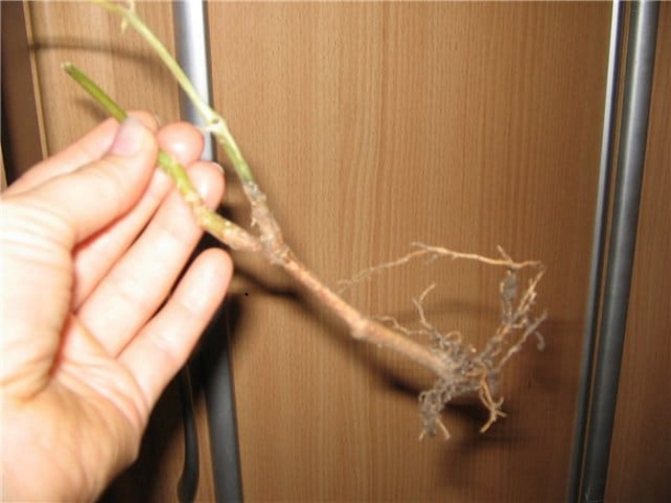

There are several ways to store geraniums in a basement:
- Pelargonium bunches are hung in the basement at a constant temperature of 2 to 7 degrees above zero. Some growers, instead of hanging them, wrap the plants in newspaper or put them in paper bags. In this case, you need to ensure that the bags are open for ventilation. Plant roots are periodically moisturized. This method is called "dry storage".
- Geraniums are planted in pots, before that the roots and stems are cut by two-thirds. The prepared plant is stored in the basement at a constant temperature of up to 10 degrees, the room should be twilight. Pelargonium planted in this way is watered infrequently, only when the soil becomes dry. This way of storing geraniums is called "canning".
Of course, not every basement is suitable for wintering your pets. Several conditions must be met:
- The room must be frost-free and dry.
- Temperature range - within +7 degrees.
- It is good if natural light is supported by the presence of a small window.
- Geranium must be pruned (all flowers and leaves are removed, only the woody parts of the plants remain).
Temperature conditions, degree of illumination, air humidity in all basements are different. Therefore, in order to understand which method will help to effectively preserve most of the plants in your case, you need to try them all. Regardless of which storage method you choose for your plants, make sure the frost hazard is over before planting them outside. Then a lush bloom will be guaranteed throughout the next season.
Pruning geraniums in autumn
In order for the plant to have a beautifully formed lush bush and to bloom profusely, it must rest.
The meaning of autumn pruning is in preparation for winter vacations. In winter, geraniums will rest from flowering, dig up strength and give growth to dormant buds.
What kind of dormant kidneys are they? Here is a trunk with a leaf on it, it grows from a leaf node. When the leaf dries up and falls off, a scar will remain in its place.
Slightly above this scar is the sinus of the sleeping kidney, it is from there that the kidney will hatch under certain conditions.
A young shoot will form from the bud, capable of providing a lush bloom of geraniums by May June.
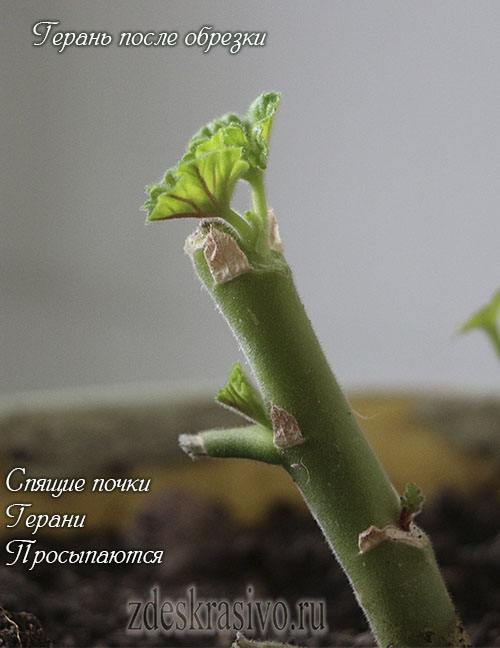

Alternative way of content
For residents of an apartment, it is often an insoluble problem to provide a cool room for their favorite pelargonium. Empirically, another method was invented. The plant overwinters in the room, as close to the windows as possible, and with the onset of spring, as soon as the air temperature rises to +2, start taking the pots out to the balcony. First, take out for 2 hours, and then gradually increase the time in the cold. This option will provide excellent geranium flowering. In principle, the plant is unpretentious, which means it can bloom without such tricks, but no one will give you a 100% guarantee.


How to prune geraniums
The soil should not be wet before pruning. The plant remains without foliage and will have nothing to evaporate moisture. Wet soil will create good conditions for rot, and the flower can be lost.
- How and what to make a cut
- How high to cut geraniums
How and what to make a cut
Correct pruning is done with a sharp tool - a knife, blade, sharp disposable cutter, pruner. This is important, as a dull blade of a scissors or a secateurs flattens the barrel a little, and it tightens worse.
The cut surface should be flat and perpendicular to the trunk, then a film will easily form on it, which will tighten and dry the cut surface.
The cut should be done 5-10mm higher than the dormant kidney.
This video is short and as clear as possible:
How high are geraniums cut
Pruned either under a "stump", leaving 2-3 dormant buds, or to a height of 10-15 cm. In the second case, you can get more shoots for spring rooting. That is, it is rather a question of reproduction. And geranium, cut “for a stump, is more often used in the future as an independent renewed lush bush.
And so: Autumn pruning is done before being brought into the cold (basement, veranda). They take it out in January - the buds wake up and begin to grow, give material for grafting, cuttings are planted in February. During the autumn pruning, geraniums are also cut into pots, in which case they will bloom earlier.
Transplants
It is necessary to select the optimal size of the pot, since its small volume stimulates flowering. But if you see roots protruding through the drainage holes, then it's time to pick up a larger pot. If a young plant grows very quickly, then you have to transplant several times a year, while the season does not really matter. Each time you need a pot only 1.5 cm larger than the previous one. Planting a plant in a large pot right away will doom it to disease. Clay pots are the best choice, but keep in mind that the soil dries out faster.


What to do after autumn pruning
Pots of cut geraniums are stored until January or February in cool places, with very limited watering or no watering at all.
Why until January or February. December is the month when the light duration of day and night is compared, this is the time of the astronomical winter. Geraniums lack natural light in such a short period and they sleep. After the day of the winter equinox, daylight hours begin to increase. By January, daylight hours will be enough to awaken dormant kidneys. Therefore, the pots are brought out into the light and in the warmth and slowly begin to water. Water sparingly, remembering that as long as there are no large leaves, the plant will not be able to evaporate moisture.
Where are the pots stored?
- In a dark cold basement at a temperature of 0-10 degrees, without watering
- On a cold veranda without watering
- In a room, on a cold windowsill. In this case, you need to water a little, because the air in the room is very dry. Once a month is enough.
Pruned cuttings can be rooted in pots, just put in water to take root (you will not believe, but this method works, by spring many cuttings will have excellent roots), or put in vases at home for beauty, especially since pruning takes place on still flowering streamers.
In January, when the day lengthens, the pots are brought into heat and watered, after having pierced a clod of earth in several places.
This geranium was brought from the basement in January
The shoots of such an overwintered geranium (it is called a mother plant) are used as cuttings for propagation or left to bloom on their root.
Storage conditions in winter
Autumn is a crucial period for gardeners when it is necessary to prepare their favorite plants for wintering. How I want to keep all the flowers so that next season they will again please the eye with an abundance of colors. Many housewives use geraniums not only as a houseplant, but also decorate flower beds with them, and plant them in pots in the open air in spring. With the onset of cold weather, you need to decide how to preserve geraniums during this period.
From December to February, pelargonium enters a dormant phase, so its growth and flowering slows down. It is for this reason that there is no need to feed the plant during this period. She needs to be allowed to grow stronger, gain strength before a new vegetative period. Until about January, pelargonium will delight its owners with bright beautiful flowers. Her vegetative period begins from mid-spring to autumn.
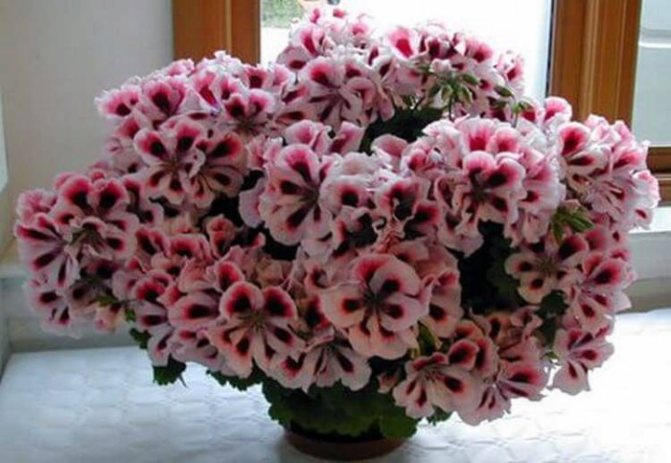

There are several ways to preserve geraniums in winter: in the basement and in the apartment. You can use the plant as an indoor plant. One of the most common ways is to cut the cuttings, root them, and plant them again in the open air in the spring.
Wintering rules
If you want to help the geraniums to overwinter, it is necessary to pre-select the plants intended for overwintering. Severely ill or too weak plants are not suitable for wintering. Strong and healthy plants overwinter better, because then you have the highest probability that pelargonium will bloom again in a year, and cuttings from it will be bred equally healthy and strong.
Pelargonium should not be stored longer than two years. Old plants should be discarded as they lose their decorative value.
Plants bloom best in the first year after rooting. To overwinter geraniums, you need to choose healthy plants that bloom profusely and grow luxuriantly.
How to prune geraniums for the winter
It is necessary to carry out the removal of geranium shoots before the onset of winter with a disinfected tool. This is a sharp knife (kitchen or clerical) or blade.
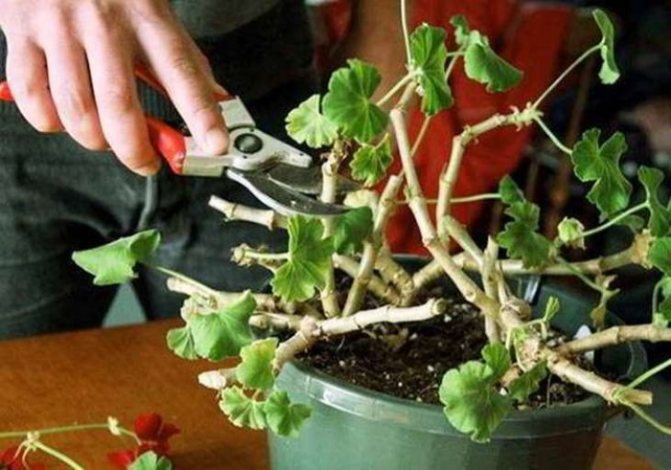

Scissors will not work for this procedure, as they pinch the stem.
- Cut off the trunk of the geranium above the leaf node in three to five millimeters.
- The cut is made at an acute angle.
- You should choose nodules aimed at the outside of the bush.
With the growth of shoots from such a bud, the shoots will not lead to thickening of the crown, since they will strive to separate from the center of the bush.
Preparing soil, balcony and room geraniums for pruning
Now it's Indian summer, and geraniums bloom magnificently, blooming so that you don't even want to think about pruning. Such a beauty.
If geranium grew in the ground in the garden
Geraniums that have grown in the ground are usually dug up and transferred to pots or containers. Before pruning, she is given a week, another to get used to a new place. As a rule, only those plants are transplanted, the variety or color of which the gardener wants to leave for the next year. The rest bloom like annuals.
If geranium grew on an open balcony or terrace in containers
Geraniums from the balcony in the same way can be transferred into one large container, or separate pots can be brought in, if there is a place.
If the geranium is indoor
Home, indoor geraniums do not need to be loaded anywhere. You need to prepare for pruning those copies that you want to rejuvenate.
The result of any autumn pruning will be the production of new strong young shoots for lush flowering in late spring and summer.
In the spring, you can plant the resulting shoots in pots or leave them on the mother plant, correcting the shape of the bush, spring pruning.
Alla Sivak has an excellent video of cardinal pruning of geraniums for lush flowering under a stump and what to do after pruning. In winter, her flowers stand at home in the light, in the warmth.
The video is not long, but if you need to quickly, then there is such an opportunity. There is a wheel icon in the lower right corner of the video. Click on the wheel, in the drop-down menu, find the word "speed". You can select speed 2 and watch the video twice as fast.
Plant feeding
Like all ornamental flowering plants, it needs regular soil enrichment and indoor geranium. Home care involves fertilizing from March to August. It should be remembered that a large amount of potassium and phosphorus is required for flowering, while an excess of nitrogen is detrimental to pelargonium. From an overabundance of it, geraniums may stop growing. With a lack of nutrients, geraniums will suffer from leaf chlorosis. It does not tolerate fresh fertilizers (manure), therefore, complex preparations for flowering plants, which are available in large quantities, should be used.
Do not feed within four weeks after transplanting, as well as during the winter. The last, autumn, fertilization will provide the vegetative part of the plants with everything necessary for growth until spring.
Possible problems
When growing geraniums at home, flower growers face the following problems:
- leaves turn yellow;
- attacked by pests;
- leaves fall;
- the stem turns black or rots;
- spots appear on the leaves.
The appearance of the listed symptoms in any case indicates an attack by pests or improper care.
Why is indoor geranium dying?
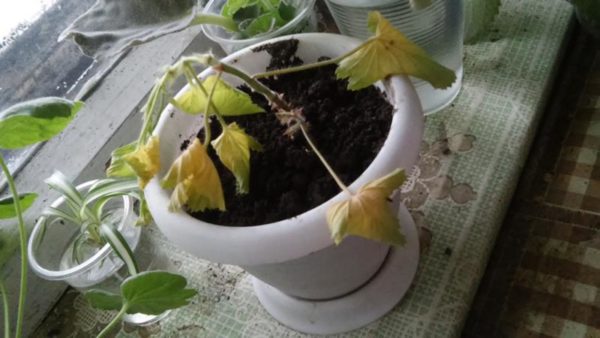

The main reasons for the death of an indoor flower:
- unregulated watering;
- excessive dryness of the air;
- high room temperature;
- exposure to sunlight;
- damage to the root system during transplantation.
There are many reasons, in order to find out the true one, you need to carefully think about what changes the flower has suffered. Often the problem is solved by changing the soil.
Diseases and pests: how to keep the ball
Geraniums are rarely affected by pests, therefore most often the plant dies when the owner does not follow the basic rules. The dying off of old leaves located at the bottom of the stem is a natural process. It is necessary to look for the reason if young rudiments wither or fall off, rust forms on the reverse side.
- If the edges of the leaf turn yellow, you need to increase the watering.
- Loss of turgor indicates excess moisture.
- Leaf fall - lack of sunlight.
Winter storage of ivy-leaved pelargonium, propagation by green cuttings
All summer long delighted us with its lush flowering thyroid pelargonium, or ivy-leaved (Pelargonium peltatum) - a close relative of the well-known room geranium. An evergreen culture of pelargonium with long (up to 1 meter) creeping shoots, with bright green, decorative leaves and beautifully gathered in inflorescences with star-shaped flowers.
The ampelous (hanging) plant is an excellent decoration for balconies, window openings, terraces, pedestals; it is planted as a creeping culture on carpet beds.
How to save pelargonium until next season?
Before the onset of frost, it is necessary to take care of the heat-loving plants of our garden - to make shelters for them or send them to winter in warm rooms. Let's think about a "winter apartment" for our pelargonium until next summer season.
We will find a place in a house or apartment where we could overwinter flowerpots with Pelargonium ivy plants. When stored properly, we observe the following conditions:
- Good room lighting;
- The optimum air temperature is from +5 to +12;
- Sparse watering to prevent root rot.
For wintering, you can use closed loggias, balconies, light attics and cold storage rooms, but so that the temperature does not drop below 0 * and does not rise above + 16 *. At the end of September, we relocate the plant for the winter, in a way convenient for you.
Autumn transplant of pelargonium shoots before winter storage.
Preparing the soil for transplanting the bushes (shoots) of pelargonium. To do this, we mix peat, turf soil and sand in a ratio of 4: 4: 2 and fill the flowerpots, and if there is a lot of planting material, boxes.
Cut off the tops of the shoots, leave them for green (uterine) cuttings, and plant individual plants in containers and bring them into the house.
In winter, do not forget to "visit" the plants - to remove yellow leaves and dead shoots. It is necessary to cut off with scissors, being careful not to damage the axillary buds.
We water it rarely so that the earthen coma does not dry out. We turn the flowerpots twice a month so that the shoots grow evenly and the bushes form even and compact.
We send pelargonium to the "winter apartment" without a change.
In the second option: we bring the plant into the room without replanting, but only shortening the shoots by 3-4 internodes. In the month of February, before the start of active growth, we transfer pelargonium bushes with roots to fresh soil. If, during the winter period, the apical shoots of the branch, they need to be shortened again.
Reproduction of pelargonium by green cuttings.
One of the reliable methods of storing pelargoniums in winter is to use cuttings. We carry out cuttings in August - September or February - March. We take a plant with healthy and strong fleshy shoots and bright foliage.
Cut off the tops with 3-4 leaves and place the cuttings in a glass of water. After the roots are formed, we plant them in flowerpots or boxes.
You can skip the stage of germinating cuttings in water, and immediately place them in a container with fertile and light soil. It is not recommended to make small mini - greenhouses, pelargonium is hard to tolerate an excess of moisture.
We apply a complex fertilizer for flower plants once every 1-1.5 months. Cuttings take root quickly, within 2-4 weeks and can grow all winter on a windowsill at room temperature, and in spring we send them back to flower hanging pots or containers.
Reproduction of pelargonium by ivy seeds.
You decided to plant the variety of pelargonium you like, but the plant is not for sale, but there are seeds. Go for it! Pelargonium ivy, propagates well with fresh seeds that have not lost their germination.
Prepare loose, well-drained soil. We scatter seeds over the surface of the soil, and cover it with a layer (2-3 mm) of peat mixed with sand on top, you can sift it through a coarse sieve. Water very carefully to prevent washing out of the seed, it is better to just spray. We make a mini-greenhouse and after 3-4 weeks the seeds will hatch.
Pelargonium is the best ampelous plant for decorating arches, balconies, windows of houses, it has a lot of advantages:
- Long bloom from May to frost;
- Throughout the season, not only the flowers of Pelargonium ivy, but also the leaves, demonstrate decorativeness;
- Differs in unpretentious care, can grow and bloom on any soil;
- Tolerates short-term drought;
- It reproduces well - many young daughter plants can be grown from one bush.
Reproduction and transplantation
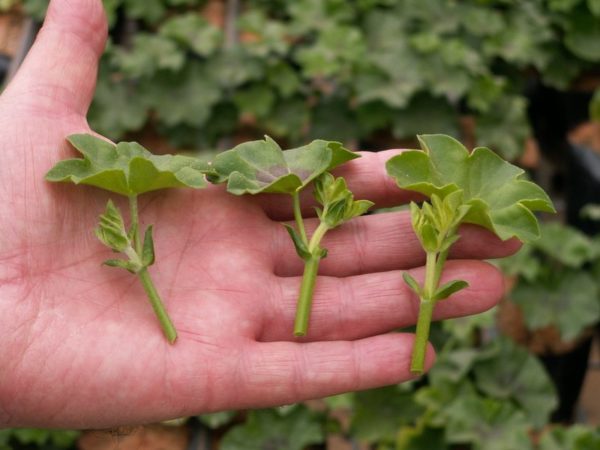

For propagation of the kalachik, 2 methods are used: cuttings and sowing of seeds. The first method has one drawback - it is important to choose the right seed. Cuttings affected by pests or diseases will not be able to take root. With the seed method, the difficulty lies in planting care. It is important not to overflow young plants and to air the organized greenhouse in a timely manner.
Seeds: how to care
Kalachik multiplies well with seeds, they can be collected independently from a flowering bush or purchased at a store.Store seeds need to be checked for their expiration date, if they are recently harvested, the germination rate will be high.
The seeds are planted in a loose, slightly moistened soil, previously disinfected with a solution of potassium manganese, sealed to a depth of 2 cm. The pot with fresh seeds is covered with glass or plastic wrap and kept at a temperature of 18-22 degrees. The glass is removed after germination. The sprout is pinched after the formation of 5 leaves. Sprayed from a spray bottle, trying not to catch the seedlings.
Transplanted into a separate flowerpot after the formation of large bushes with 2-4 pairs of true leaves.
Growing by cuttings
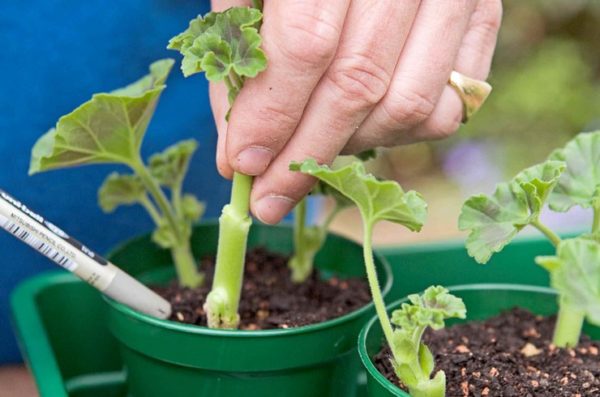

It is quite simple to grow a full-fledged plant from a cuttings. To do this, use the leftovers after autumn or spring pruning. It is better to choose cuttings with a lignified trunk. There are several popular rooting methods:
- Water. An activated carbon tablet is added to a small container with water and a stalk is placed in it. The glass is placed on a well-lit windowsill and the roots are awaited. The process of their appearance in the spring takes about a week, and in the fall more than a month. The main risk when using this method is rot.
- Perlite or vermiculite. The stalk is rooted in moist perlite or vermiculite, placing the sprout at a slight angle - this way the young plant will spend less energy on its own support. The plant is placed in a consecrated place or under a phytolamp.
- Peat. It is convenient to use a peat tablet. It must be soaked in water before use. After its opening to the volume of the glass, a stalk with a cut obliquely is placed in the center. The advantage of this method is the ability to do transshipment later instead of transplanting. This method has the advantage - peat in tablets is disinfected, therefore the risk of death of the cutting is minimal.
- Priming. In the soil, the plant takes root, as in a peat tablet, only the substrate must be pre-prepared. It is coughing up in the oven or spilled with manganese for disinfection.
Read also 250 grams of honey is how many tablespoons
The cuttings are transplanted into a permanent flowerpot after noticeable growth and the formation of new leaves. It is better to wait for the moment when the roots will entwine all the existing earthy clod.
Landing
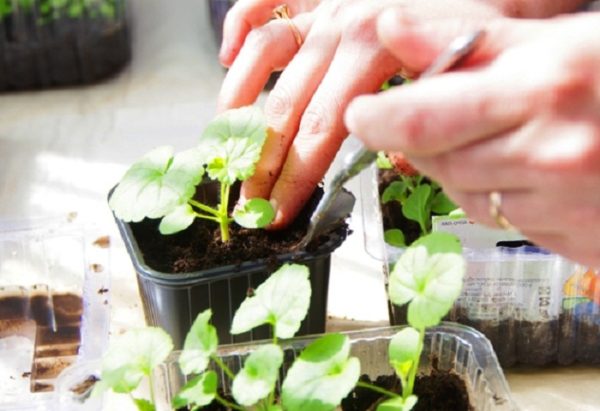

It is necessary to transplant the plant carefully due to the fact that its root system is delicate. The new flowerpot should be two centimeters larger in diameter than the previous one. Using a large pot is not worth it, because the plant will not bloom. Geranium, rooted from cuttings, or a bush after wintering is recommended to be planted in April - during the period of growth and development.
Transfer
Before replanting, the kalachik needs to be watered with water. So, it will be easier to remove the earthy clod from the flowerpot. The transplant is carried out in spring or autumn, after the end of flowering. After transplanting into new soil, the plant is not fed with fertilizers for 4 months. The substrate contains all the nutrients necessary for growth and development.
Medicinal properties and benefits of the flower
Zonal pelargonium leaves release essential oils into the air and destroy viruses and bacteria in the room. The plant is recommended to keep in the nursery because it calms and improves sleep. The leaves of the plant are used for otitis media, rhinitis and rheumatism. They make an infusion for the treatment of diseases of the gums and throat.
According to popular belief, the blooming of red geraniums in the apartment testifies to love and mutual understanding in the family. The plant normalizes the aura, makes the psycho-emotional environment more comfortable for life.
Necessary soil and pots
In order for the plant to bloom and delight in the brightness of colors, it is important to choose the right container for planting. On the balcony, the pots familiar to everyone will look good: oval, round. You can use square containers that are attached to the railing. But in this option it is necessary to check the additional reliability of the fasteners.
Such a pot should have a tray without a drain so that dirty water does not pour down.Geraniums on the balcony can be attached to the wall by placing them in pots or floor boxes. They can be placed on a stand with castors for easy relocation. The optimal drawer depth is about 18 centimeters. If the container is wide, then the plant can be planted in two rows.
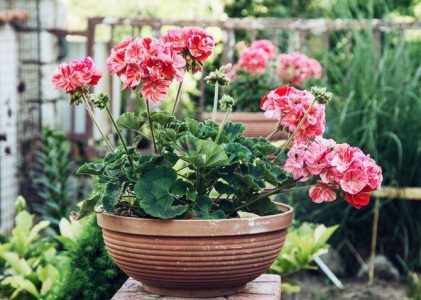

The soil for planting and growth should be neutral or slightly acidic. It is better if it is light, because compacted soil contributes to stagnation of water and rotting of the root system. It is advisable to buy ready-made soil, universal mixtures should not be purchased.
Geranium in the garden and on the balcony


These boxes are easy to carry, which makes it easier to care for the plant.
It turns out that many summer residents plant geranium bushes in the garden. It blooms from the end of May to June, but even after the bright flowers fall off, the neat bush looks very beautiful like a living border. The main thing is to cut off the peduncles and form neat round green balls.
Geranium leaves are very beautiful, carved. The hybrids have a very interesting leaf color - from light green to rich marsh color, with carved patterned veins. Therefore, even after the geranium has faded, the carved leaves will look beautiful in a box on the balcony or loggia.
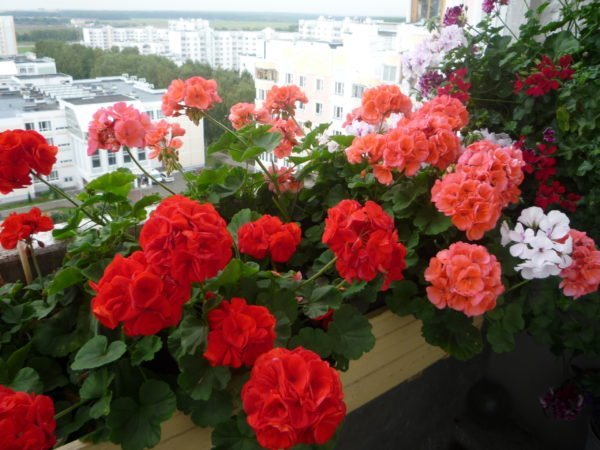

We install the box 50 cm below the railing so that the plants do not break with the wind.
In the garden, geraniums are propagated by seeds very simply. They just cut the flower stalk with seeds and lay it on the ground, in the place where they want new flowers to grow.
But, I think, in addition, it is necessary to cover the cut branches with sprigs of needles so that the wind does not scatter light seeds. In addition, the needles retain moisture and in the spring the seeds will definitely sprout.
On the balcony, it is better to grow this flower with your own hands in tall compact boxes or clay pots, which can be transferred to the windowsill for the winter. Then in winter, with good care, it will be possible to get a second flowering. After all, this plant is native to South America, and in natural conditions it blooms twice a year.
Seeds or cuttings


Balcony grille is the best support for tall geraniums
It is more convenient to propagate geranium by cuttings. In order to get a young bright bush, we cut off a branch of the mother plant.
The tops with adjacent internodes or lateral branches with three to four ramifications are suitable for cuttings. You can also take the middle part of the shoot with two or three branches for the cutting, but not the part that has already become stiff. The stalk should be green.
We cut off the shoots with a sharp knife, scissors pinch the outer protective film and the plant does not receive the required amount of water and oxygen for growth. Cut off the stalk half a centimeter below the location of the leaf. Before putting the cutting into water, remove all the lower leaves, and carefully pinch off the inflorescences.


In the photo - ways to trim the cutting for rooting
It is imperative to let the cut site dry a little so that the cutting does not rot. Usually three to eight hours are enough for this, depending on the air temperature. A thin film should form at the cut site.
Instructions for propagating geranium by cuttings:
- Before planting the cutting in the ground, it must be disinfected at the cut with charcoal.
- A mixture for planting cuttings: sod earth and sand (the first layer is 6-7 centimeters), the top layer is calcined clean river sand or perlite (three to four centimeters).
- At the bottom, it is imperative to lay a drainage layer of pieces of foam plastic or broken ceramic fragments.
- The mixture must be wet for planting. If you are not sure about the quality of the soil, then you can water the soil with a weak solution of potassium permanganate to kill putrefactive bacteria.
- We plant the cuttings in moist soil at a distance of 6 - 7 cm from each other, compact the earth around the stem and leave to take root.
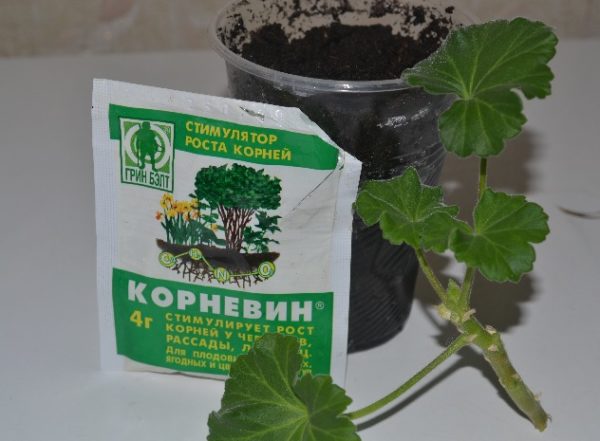

The best fertilizer for a healthy root system
After planting, the cuttings do not water for two to three days. Watering should be started as the soil dries out so that the roots do not rot.
- Twigs take root for about a month. To do this, we put the boxes with cuttings in a lighted place, but shade so that direct sun rays fall on the plant. The temperature for optimal germination is from 18 to 22 degrees, not higher.
- The yellowed leaves from the twig cannot be torn off, only cut off, leaving part of the leaf. If you cut it off, you can damage the stem, and this will provoke the development of the fungus..
Home geranium care, disease and treatment
Many diseases and parasites bypass geraniums, but there are pests that do not care about its peculiar smell. Most often, the whitefly settles on pelargonium. If there are few parasites, then the plant is treated with soapy water and covered with a film, but if the damage is serious, then you will have to resort to chemicals, of which there are a lot on sale. Appear on geraniums and spider mites. You can fight them only with the use of special drugs.
A fungal disease that is very common on this plant is the so-called black leg. It affects both young and adult plants, and the reason for its appearance is waterlogging and poor drainage system.
Care features
Planting and caring for geraniums outdoors does not require special skills. Even a novice amateur gardener will take great care of her. The main requirement is regular watering. Plants are not particularly demanding on the composition of the soil, some varieties thrive on rocky soils. They are equally good in the sun and in semi-shaded areas. In wetlands, the plant grows poorly and is sick.
Where to plant
Perennial garden geranium - planting and care in the open field
Since there are a lot of geranium varieties, the plant can be planted in almost any area with different levels of illumination and moisture.
What soil does geranium like
The land for geraniums must be fertile. There should be no stagnant water at the landing site, due to which the site is capable of swamping. If the soil contains too much clay, then peat and compost are added to it.
Watering
The plant requires regular and moderate watering. You need to water at the root. Moisture is retained using mulch.
Important! It is strictly forbidden to flood a plant, especially an indoor plant - from this, the root system begins to rot. Due to frequent watering, flowering stops. At the same time, drought is undesirable - the flowers will be very small, and the leaves will fade.
The ideal watering frequency is to do it at a time when the soil is dry.
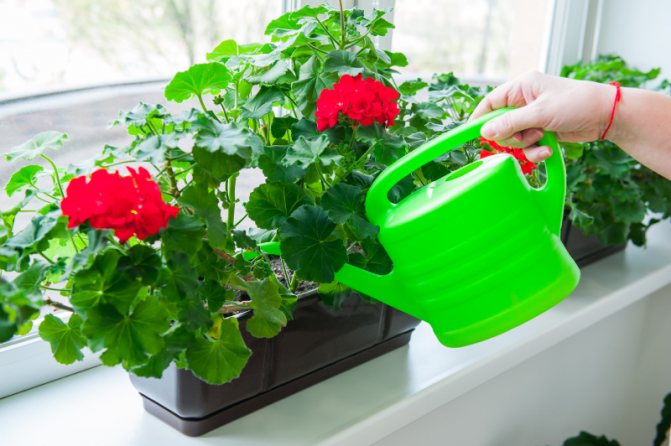

Caring for geraniums at home
Top dressing
Geranium does not need intensive feeding. For normal flowering, ordinary humus is quite enough. An excessive amount of fertilizer has a bad effect on the flower formation process.
Fertilizers containing phosphorus are used before flowering. Potash fertilizers are applied during the appearance of flowers and ensure the growth of lush, beautiful inflorescences.
What temperature can it withstand outside
The normal average temperature for a flowering plant is 18 to 25 degrees. If there are geranium flowers in a pot, you need to remove it indoors at a temperature below 10 degrees.
The plant is able to withstand temperatures up to 5 degrees. When the temperature drops, the growing season stops. Since geranium is winter-hardy, it overwinters well under a layer of snow. If the winter has little or no snow, then with the onset of cold weather it is enough to cover it with leaves or spruce branches. In the south, geraniums can hibernate without shelter during warm winters.
Pruning
The geranium needs to be pruned. This is done in order to keep the optimal shape of the bush and the density of flowers. By pruning, the decorative appearance of the plant is maintained.
It also helps keep the shoots healthy. Dried shoots are a favorable breeding ground for gray rot.
When to bring pelargonium indoors?
To begin with, we recall that indoor geranium is divided into several independent species: zonal pelargonium, ivy (ampelous), angels pelargonium, royal and fragrant.
The easiest thing is with the wintering of fragrant pelargonium and traditional zonal pelargonium ("kalachiki"). With constant cultivation in an apartment, old "grandmother's" varieties require a minimum amount of attention, but with a sharp change in conditions, even they can react negatively, not to mention modern hybrids.
As you know, the older the plant, the harder it tolerates changes in environmental conditions, so many growers prefer not to get involved with overexposure of mother plants, but decide to renew flowers from cuttings every year so that small young plants leave for the winter.
To do this, it is necessary to cut off cuttings from pelargoniums, without waiting for autumn - in mid-late August, and initially grow the young as indoor flowers. Then the onset of winter will not cause particular stress for geraniums.
But not every flower lover rises up to throw away a chic voluminous bush. In addition, it has been noticed that in the second year the plants give especially lush flowering. Moreover, in modern dwarf and mini-varieties, bushes develop very slowly and this method is unacceptable for them.
For a short time, pelargoniums are able to tolerate a small temperature minus. But if you are determined to move geraniums to an apartment for the winter, then it is better not to bring it to significant cold weather. The later the plants get into the room, the longer the period of adaptation to the changed conditions will last.
For the most painless adaptation, it is better to plan the move (on average) at the end of August-beginning of September. It is possible to determine that the plants are no longer comfortable with the outside temperature by such signs as significant reddening or yellowing of foliage and peduncles.
Read more about the types and varieties of pelargoniums in the material Pelargonium - the most hardy of the flowering flowers.
Planting and breeding
The plant can be planted in pots in two ways:
- Seeds. Breeders have bred many varieties of geraniums grown from seeds. It is necessary to sow them from September to April. The soil must be loose and decontaminated. After planting the seeds, the pot is covered and kept at 20 degrees. The first shoots will appear after 10 days. It is important to maintain moderate soil moisture. The total period for growth and flowering is about five months.
- Cuttings. All types of geraniums propagate by cuttings in the same way. For cuttings, side shoots, plant tops and middle parts of shoots with several branches are used. Cut the cuttings with a sharp knife about five millimeters after the leaf node. Then the slices are dried for about five to eight hours to form a film that protects them from decay. Immediately before planting, the cut is sprinkled with charcoal.
Preparing for landing:
- Prepare a soil mixture from turf - a layer of six centimeters and calcined sand - four centimeters. You can use a commercial soil mixture for geraniums.
- Place a pebble or broken ceramic drain on the bottom of the pot.
- Moisten the planting mixture and disinfect it with a weak composition of potassium permanganate.
- The cuttings are planted six centimeters apart, compacting the soil tightly.
- The first watering is carried out after the soil is completely dry.
- Throughout the month, cuttings should be protected from direct sunlight and the temperature regime should be observed in the region of 20 degrees.
After 30 days, the cuttings are planted in a permanent place:
- Drainage is placed at the bottom of the pots and a little prepared soil is poured, complex fertilizer is added.
- Pour out the remaining soil and plant the cutting, gently spreading the roots.
- The plant is watered and placed in partial shade for a week until it grows.
After all the manipulations, the geranium is placed in a bright place. For tillering shoots, you can pinch it.
When in the spring can you take geraniums outside, a balcony?
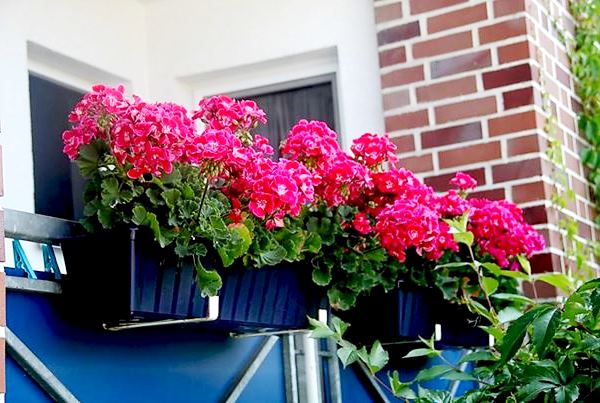

Most varieties of this flower tolerate frost well, and actively begin their growth in a new place. On this basis, it can be planted in the ground as soon as the threat of night frosts passes.
In each region, this time comes in different ways, but usually the planting of geraniums can be carried out already in the first ten days of May. It is at this time that the rhizomes of the plant can warm up to the desired temperature of 15-18 degrees.
The choice of planting material will also affect the timing of planting a flower.
Planting process
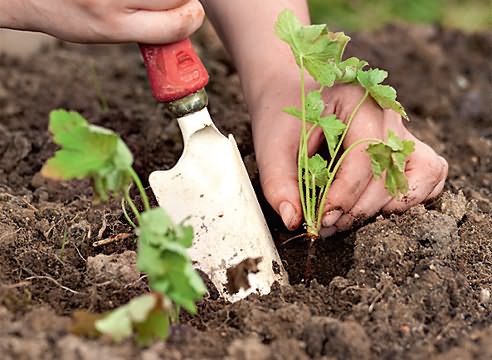

Previously cut cuttings and planted in cups, which have been hardened, are taken outside and left until disembarking.
Then the planting process is as follows:
- Digging a hole.
- Planting a bush and covering it with earth.
- Light watering and compacting the soil around the seedling.
- Pinching of the apical bud, so that a thick bush subsequently forms.
During the rooting of the seedling, you need to cut off its lower leaves, otherwise they will still turn yellow. To get a rolling bush, you need to pinch every 10 apical leaf, and do the same with the side shoots.
All about how to properly handle geraniums in winter and preserve until spring: the subtleties of care
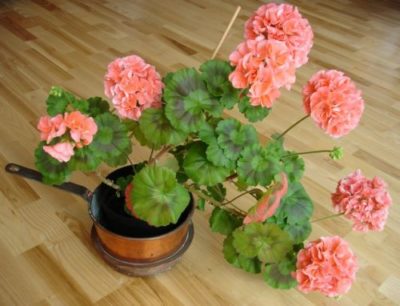

Closer to winter, like many plants, geranium requires special care, the provision of which must be competent, because only in this case, in spring and summer, it will be able to delight the eye with its abundant flowering.
How to organize proper care of geraniums in winter and spring? How to prune before wintering and keep the plant at home? For more information, see the article below.
Geranium features
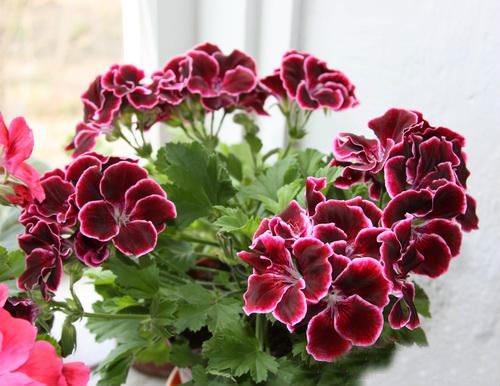

The plant got its name back in the 1st century AD. BC, its beneficial properties were highly appreciated by many healers, and it became popular in Europe. In Russia, it began to be grown in the 18th century. Now more than 400 species of pelargonium and 200 species of its South African families have been bred.
On the street, wild geraniums can be found in meadows, on the banks of rivers and lakes, in coniferous and deciduous forests. Its cultivated varieties show unpretentiousness to harsh weather conditions, they bloom twice a season, they can withstand severe winters and dry summer days.
Now, along with simple varieties, there are hybrids with double flowers, their colors are very diverse, some colors in the wild cannot even be found. And the leaves are both monochromatic and combined.
New varieties bred by breeders differ from each other in a diverse range of colors, not only of flowers, but also of leaves, which can be dissected or rounded.
Pelargonium pruning
All pelargoniums are pruned sooner or later. I know some lovers of this plant, who would never agree to "shred" their overgrown bushes in the fall. Even when they have lost all decorativeness and are tied to numerous supports so as not to collapse and break. But what about those flower growers who are unrealistic to fit heavy boxes or pots with blooming pelargoniums in a house or other enclosed space?
Summer and early autumn are a time of exuberant growth and flowering, when compact bushes turn into lush voluminous bushes. In order for them to bloom again profusely and become decorative next year, more or less strong pruning is necessary. When and "how much" to cut depends on many reasons. This is the state of a specific pelargonium, the shape of the bush, the expected conditions of detention in winter and summer, etc.
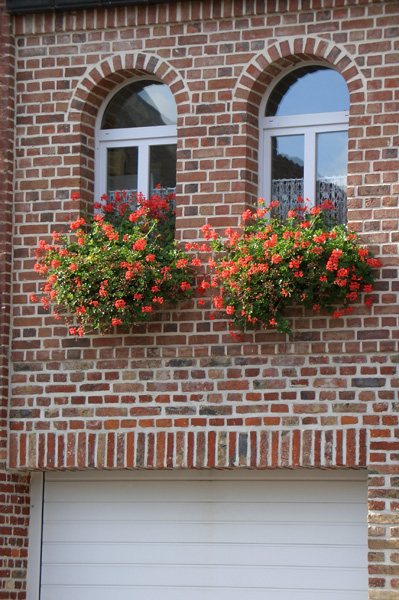

A bit of history and features of cultivation
Indoor geranium came to the countries of Europe almost 300 years ago from the southwest of Africa. Over the past centuries, new varieties of geraniums have been bred with a varied shape of buds, leaf colors and inflorescences. She willingly decorates not only houses, but flower beds and flower beds. Geranium can be used to decorate balconies in hanging pots and boxes. The plant has become one of the most popular and loved ones.
Of the more than thousands of known geranium varieties, almost all grow optimally on the balcony and loggia. The main thing is to create the conditions necessary for the growth and flowering of the plant. Pelargonium is a light-loving plant. It loves the sun, but not its direct hot effect, but being in partial shade. Carries dry air and does not need to be sprayed. The plant does well at low temperatures. Most suitable conditions: cool nights and warm days. At the same time, the plant gains strength, does not stretch and always blooms.
Let's sum up
As you can see, caring for home geraniums is not difficult at all. Diseases, reproduction, watering and feeding - what causes so many difficulties for growers when breeding capricious tropical flowers is not a problem when growing pelargonium. The care is intuitively simple, the drugs for the treatment are freely commercially available. The only moment that can cause some difficulty is pruning and forming a beautiful bush. For the first time, it is better to resort to the help of an experienced grower.
Summary


Decorating a balcony is easy!
Geranium looks beautiful both in clay pots and in balcony boxes. It is only important that the drawers are removable. So it is easier to remove them in the shade or bring them into the house in extreme heat.
In the video presented in this article, you can learn in detail the rules for planting a plant in the ground and some secrets of caring for this cheerful, cheerful flower.
I will be glad to discuss the topic in the comments and find out interesting nuances of growing geraniums in the garden and on the balcony.
Geranium is a houseplant known to many. Our grandmothers also loved to decorate their windowsills in houses with it. She pleases with a rich varied palette almost all year round. Geranium is unpretentious in care and with its bright colors can decorate not only an apartment, but also revive any balcony.


Geranium preparation
Only strong and strong plants should be left for wintering, and weak ones with signs of diseases or the presence of insects should be discarded.
A mandatory procedure before digging geraniums for the winter is pruning. In September, you should pinch off (not cut off) dry and starting to dry leaves, and at the end of the month remove all peduncles - faded and not yet blooming. Removing the peduncles helps to preserve the vital resources of the plant for the winter.
After 2-3 weeks, when the dug plant adapts to the wintering site, cut off all shoots 1/2 or 1/3 of their length (3-5 cm above the node).
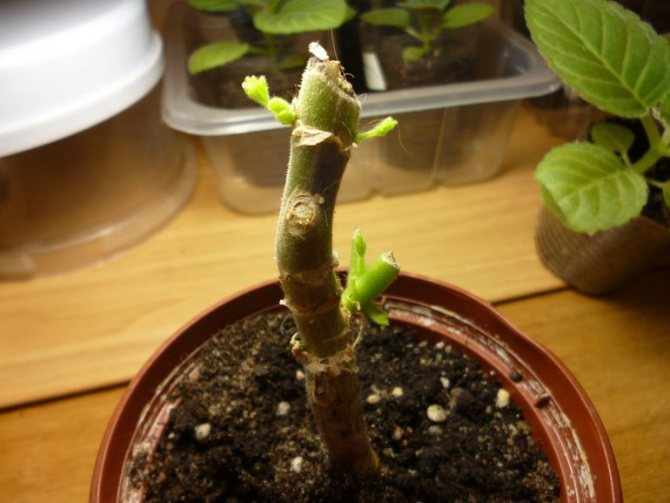

Reference! Pruning is not carried out in variegated and miniature geranium species, and in ivy-leaved lashes 40-50 cm long are left.
Does geranium overwinter outdoors
In summer, geraniums pleases with abundant flowering in the garden. Pelargonium, or geranium, is native to South America. The flower does not tolerate low temperatures, so it is taken into the house for the winter. What are the subtleties of transplanting geraniums in the fall from the garden, we will tell you in this article.
Features of geranium transplant
Pelargonium should be transplanted before the thermometer drops below 100C. For central Russia at the end of August - mid-September. Before transplanting, the plant must be prepared. Pedicels and dry leaves are cut off. Young shoots are suitable for transplanting, so it is advisable to remove the old part of the plant. The pot is chosen such that the root system is free, but do not use too large a container, otherwise the geranium will not bloom.


Soil preparation for pelargonium
You can buy soil for pelargonium ready-made or mix humus for 2 hours, sand for 1 hour and peat for 1 hour. The root system of a plant can become moldy if you take heavy and stale soil. The plant loves nutritious and loose soil. After transplanting, the earth is not rammed; once a month, the top layer is additionally loosened. Geraniums need a high sod layer (at least 2 cm).
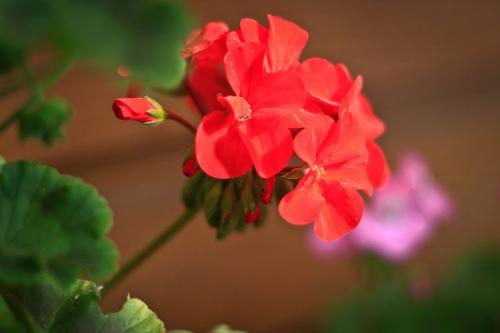

Pelargonium bait after transplant
The plant accepts fertilizing with mineral compositions well.At the end of winter, they begin to feed them with potash and phosphorus compounds. On the other hand, nitrogenous ones are reduced. This promotes abundant flowering in spring. Top dressing is carried out once a month (in winter and autumn) and once a week (from early spring to late summer). Two weeks before transplanting into the house, the bait is stopped.
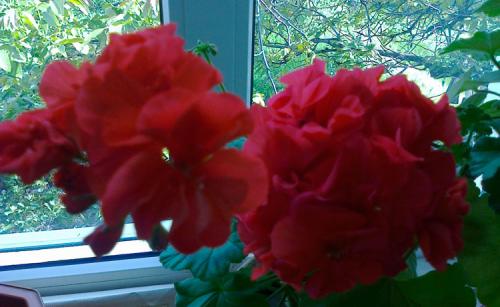

Lighting and temperature
Geranium should overwinter at a temperature of 8–10 ° C, but it tolerates an ordinary room one well. Do not put a flower on the south windows. Although the plant loves light, the afternoon sun is unacceptable. Twilight will have a detrimental effect on flowering. In the spring, geraniums can be transferred to the loggia before disembarking in the garden.
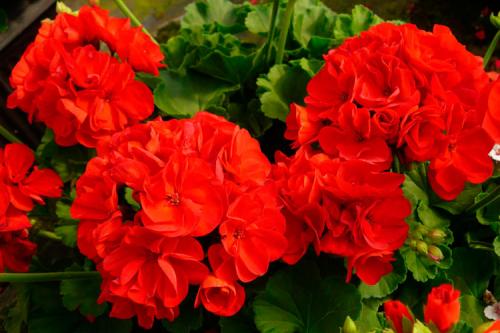

Humidity and watering
Geranium is moisture-loving. Watering abundantly should be done daily. Water for irrigation should be at room temperature.
The humidity in the room is allowed at least 20%. In apartments with a central heating system, the leaves are treated with a spray bottle every two days.
Possible mistakes
The Pelargonium plant is unfriendly, but if you make mistakes when leaving, it will get sick and may die. Let's take a look at some of the most common mistakes:
- Overflowing. The leaves are willing and falling off. It is necessary to let the soil in the pot dry out, then loosen the top layer.
- The temperature is too low. The edges of the leaves turn red. Delivery of the flower to a warmer room.
- The soil is heavy. The leaf desires and falls, the root system began to rot. It is necessary to change the soil.
- The plant is infected with microorganisms. Gray spots appear on the leaves, the trunk dries. It is necessary to work with fungicides, change or sterilize the soil, remove the affected leaves.
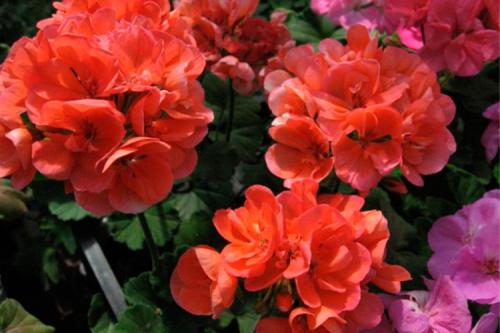

Transplanting geraniums from a garden to a pot in the fall is a simple process. The most important thing is to follow the exact rules of the recommendation.
Pelargonium wintering places
The following conditions are suitable for wintering:
- glazed balcony or loggia, provided that the temperature does not drop below 8-10 degrees;
- window sill at a room temperature of no more than 17 degrees;
- cellar or basement - plants in flowerpots are placed in the lightest place, if it is impossible to provide natural light, the method is not used;
- refrigerator - without soil and roots, leaving only the ground part in the form of a stem, you need to regularly check the condition of the plant.
For adult plants to successfully overwinter, they must retire healthy. At the end of August, plants planted in open ground should be examined for pests.
Plant propagation
As already mentioned, cut cuttings are used for this. Some growers recommend choosing the time for planting, namely August-September, but in fact, this is how the procedure is timed to plant young plants. In general, you can plant throughout the year, this opportunity is provided by an unpretentious geranium. Minimal care is required for such a plant as geranium. At home, reproduction, flowering will pass without problems if you pay enough attention to your green friend. No special skills are required from you.
In order to grow a new flower, you need to take a fresh stalk 10-15 cm long. In the smallest varieties, a stalk about 2 cm long can be used. No more than 4 leaves are left on it and allowed to lie in the open air for a couple of hours to dry out. After that, it is planted in a small glass and placed in a warm and bright place for rooting. After about three weeks, the first roots will appear, after which it will be possible to transplant the young geranium into a larger pot.


The plant grows poorly - what is the reason?
In some cases, gardener errors cause plant diseases. If leaves fly off the branches, the lower part of the geranium is exposed and flowering is delayed, then it most likely does not have enough light. A huge, lush bush with a complete lack of flowering is usually obtained with an excess of fertilizer. If the lower leaves of the geranium turn yellow, then you need to pay attention to watering. Surely it is irregular, or the soil is too sandy, drying out quickly.If the leaves are dry and watering is normal, then the air temperature may be too high.


For coloristic ideas - dark-leaved varieties
Meadow geranium has several varieties with maroon almost black foliage. Started with Victor Reiter, but it doesn't have the darkest foliage. Varieties of the same meadow geranium, different in height, are very decorative: Midnigth Reiter, O’key Dokey, Hocus Pocus, Black Beauty, Purple Heron. With their carved leaves, blue-blue rather large flowers look harmoniously. There were varieties with brown foliage in spotted geraniums - "Espresso" and "Elizabeth Ann". Red-brown geranium pleases with purple-brown spots on a dark green background of carved leaves. The Samobor variety is especially good. Here foliage dominates, flowers are much more modest.
To the content
Geranium keeping conditions, temperature conditions
Almost all year long, the flower feels normal at the most ordinary room temperature. It does not require greenhouse conditions and, in general, is surprisingly unpretentious. Geranium requires a little more attention in winter. Caring for her at home requires a cooler maintenance regime, about +10 degrees. It is optimal to take the pot with the plant into a cool room, if this is not possible, then you can safely do with the window sill, it always pulls cold from the glass. The main thing is to make sure that the leaves do not touch the window.
This is especially important if you are growing a royal geranium, known for its beautiful flowers. It is she who is very demanding on the conditions of winter keeping, at high temperatures (+20 and can drop all the buds. Therefore, +10 degrees is the maximum (up to +4) that geraniums accept in winter. Home care also involves providing good lighting, therefore, the basement is not suitable. If you have the pots near the north window, then additional artificial lighting will be required. A separate issue is watering the plant in winter, but we will talk about this a little later.
Care after landing


All work on planting and transplanting pelargonium is best done in the spring. It does not require special care, but to get a beautiful bush you will have to take some rules:
- Water the plant regularly and abundantly, but do not flood it and do not allow water to get on the leaves, it is best to start a watering can under the root, but do not bring the liquid to stagnation.
- To carry out top dressing on time, the first can be carried out immediately after transplanting or planting a plant. Peat or compost is used as fertilizer.
- In the summer, dried inflorescences should be removed in a timely manner in order to prolong flowering, and to achieve the decorative effect of the bush.
- In the fall, it is necessary to prune all dead leaves and branches to give life to new shoots next year.
- In the spring, it is imperative to feed the plant with nitrogen fertilizer, this will act as a powerful stimulant for the development of dense and rich foliage on the bush. A month after this feeding, a second one is introduced, when choosing which one should take into account that it should contain potassium, fluorine, nitrogen and trace elements.
- Fertilizer is applied for different species of its own, so for mountain plants there should be less fertilizing than for those that were bred for planting on the plain.
- In preparation for wintering, the plant is pruned and mulched.
- In the event that it was decided to plant the garden geranium in a room pot, it is imperative to make a drainage layer for it.
Perennial pelargonium is an undemanding plant that can decorate any flower bed. She does not need special care and perfectly complements other decorative flowers in a group planting. When creating conditions suitable for her, the plant blooms all season, if this does not happen, then you need to introduce top dressing in a timely manner or transplant it in the spring to another place.
Geranium is a houseplant known to many. Our grandmothers also loved to decorate their windowsills in houses with it.She pleases with a rich varied palette almost all year round. Geranium is unpretentious in care and with its bright colors can decorate not only an apartment, but also revive any balcony.


